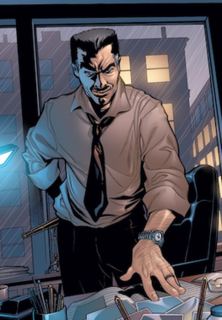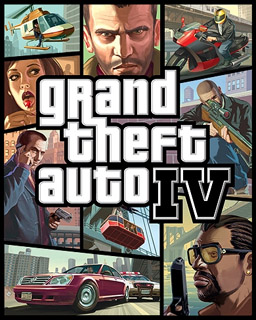The Daily Bugle is a fictional New York City tabloid newspaper appearing as a plot element in American comic books published by Marvel Comics. The Daily Bugle is a regular fixture in the Marvel Universe, most prominently in Spider-Man comic titles and their derivative media. The newspaper first appeared in Fantastic Four #2, and its offices in The Amazing Spider-Man #1. The Daily Bugle was first featured on film in the 2002 film Spider-Man. The fictional newspaper is meant to be a pastiche of both the New York Daily News and the New York Post, two popular real-life New York City tabloids.

MacDonald "Mac" Gargan is a fictional character appearing in American comic books published by Marvel Comics. During his career as a supervillain of Spider-Man, the character originally appeared as the most well-known incarnation of Scorpion, and later becomes the third host of the Venom symbiote.

Elizabeth Brant is a fictional character appearing in American comic books published by Marvel Comics. She is the personal secretary working for J. Jonah Jameson at the Daily Bugle, and thus acting as both a supporting character and love interest for Peter Parker/Spider-Man, and eventually becoming the girlfriend of Flash Thompson/Agent Venom.

Eugene "Flash" Thompson is a fictional character appearing in American comic books published by Marvel Comics. He is a star high school football player who mercilessly bullies his high school classmate Peter Parker but greatly admires Spider-Man, an irony in which the superhero takes some gratification. In time, they become close friends in college after Flash matures and he later on discovers Peter is Spider-Man. After graduation, he joins the United States Army and is haunted by his combat experiences, leading to alcoholism. After losing both of his legs in the Iraq War, he turns into the superhero Agent Venom after being bound to the Venom symbiote which he controls via drugs. Eventually during an argument between him and Eddie Brock regarding the Venom symbiote, he is the new host of the Anti-Venom symbiote.
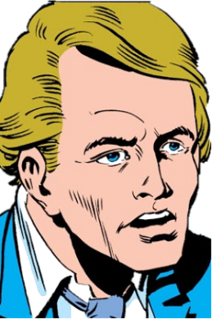
Edward "Ned" Leeds is a fictional character, a supporting character appearing in American comic books published by Marvel Comics. A supporting character of Spider-Man, he was a reporter for the Daily Bugle, and the husband of Betty Brant. He was also the third character to take on the Hobgoblin mantle after being brainwashed as a stand in.
John Jonah Jameson III is a fictional character appearing in American comic books published by Marvel Comics. He is the son of J. Jonah Jameson.

Joseph "Robbie" Robertson is a supporting character in Marvel Comics's Spider-Man series. Created by Stan Lee and John Romita Sr., he first appeared in The Amazing Spider-Man #51.
Frederick Foswell, also known as the Big Man and Patch, is a fictional character appearing in American comic books published by Marvel Comics.
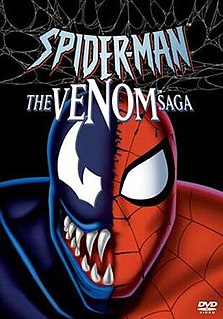
The Venom Saga is a story arc from the 1994 animated series Spider-Man that focused on Venom. The description of the name and chosen episodes debuted in home media by Buena Vista Home Entertainment. The first three episodes are the three-part episode entitled "The Alien Costume" from season one. The last two are the two-part episode entitled "Venom Returns" and "Carnage" which debuted in season three. These certain episodes are responsible for debuting the symbiotic characters Venom and Carnage outside of comic books. The arc was released on DVD as Spider-Man: The Venom Saga.
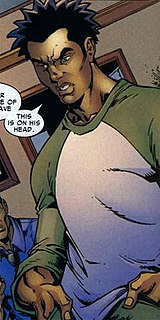
Randy Robertson is a fictional character appearing in American comic books published by Marvel Comics. He is a supporting character in Marvel's Spider-Man series and is depicted as the son of Robbie Robertson.
The Century Club is a fictional gentleman's club in Manhattan for wealthy executives set in the Marvel Comics Universe, specifically in the Spider-Man titles. The club was first shown in Amazing Spider-Man #23 however was not referred to as The Century Club until Peter Parker, the Spectacular Spider-Man #80. The Club played a major role in the Hobgoblin mystery storyline that ran through the Spider-Man titles in the 1980s.

Gloria Grant, more commonly known as Glory Grant, is a Marvel Comics supporting character of Spider-Man. She is introduced in The Amazing Spider-Man #140 as a neighbor of Peter Parker. Peter then helps her secure a position as J. Jonah Jameson's secretary at the Daily Bugle, replacing Betty Brant.

As a character, Venom has appeared in a number of media, from comic books to films and television series. Each version of the work typically establishes its own continuity, and sometimes introduces parallel universes, to the point where distinct differences in the portrayal of the character can be identified. This article details various versions of Venom depicted in works including Marvel Comics Ultimate universe and What if issues.
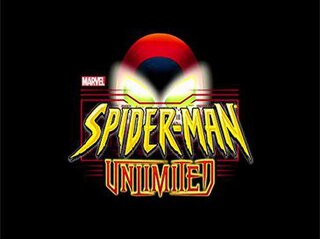
Spider-Man Unlimited is an American animated series by Saban Entertainment which features the Marvel comic book superhero Spider-Man. Unlimited premiered in 1999, and though it had fair ratings, it was overshadowed by Pokémon and the newly debuted Digimon, and canceled after airing only a few episodes. Fox Kids later resumed airing the show from 2000 to 2001, airing 13 episodes, the last ending on a cliffhanger.
The Savage Six is the name of two different fictional villain groups appearing in American comic books published by Marvel Comics.
Max Modell is a fictional character appearing in American comic books published by Marvel Comics.
"Go Down Swinging" is a four-issue comic book storyline in The Amazing Spider-Man, first published by Marvel Comics between March and May 2018 and featuring the fictional superhero Spider-Man.





